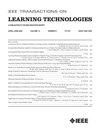Predicting Student Engagement Using Sequential Ensemble Model
IF 2.9
3区 教育学
Q2 COMPUTER SCIENCE, INTERDISCIPLINARY APPLICATIONS
引用次数: 0
Abstract
Predicting student engagement can provide timely feedback and help teachers make adjustments to their practices to meet student needs and improve their learning experience. This article proposes a four-step approach using a sequential ensemble model for engagement prediction, discusses the contribution of different features to the model and the influence of video segmentation in the prediction, reports on two in-the-wild datasets-The Emotion Recognition in the Wild Engagement Prediction (EmotiW-EP) dataset published in 2018 as part of a student engagement task and the Dataset for Affective States in E-Environments (DAiSEE), a general purpose dataset also used in the educational context but not limited to it, and, finally, presents a comprehensive and thorough critical analysis, highlighting crucial factors to consider when using AI/computer vision models in educational datasets for learning purposes. Experiments show that our proposed approach outperforms state-of-the-art approaches by obtaining a mean square error of 0.0386 on the DAiSEE dataset and 0.0610 on the EmotiW-EP dataset. We conclude this article with a critical analysis of the reliability of such predictions in learning environments and propose future directions for the effective use of AI/computer vision models in education.利用序列集合模型预测学生参与度
预测学生的参与度可以提供及时的反馈,帮助教师调整教学方法,满足学生的需求,改善学生的学习体验。本文提出了一种使用序列集合模型进行参与度预测的四步方法,讨论了不同特征对模型的贡献以及视频分割对预测的影响,报告了两个野外数据集--作为学生参与度任务一部分于2018年发布的野外参与度预测中的情感识别(EmotiW-EP)数据集和电子环境中的情感状态数据集(DAiSEE)、最后,提出了全面而透彻的批判性分析,强调了在教育数据集中使用人工智能/计算机视觉模型进行学习时需要考虑的关键因素。实验表明,我们提出的方法在 DAiSEE 数据集上的均方误差为 0.0386,在 EmotiW-EP 数据集上的均方误差为 0.0610,优于最先进的方法。最后,我们对学习环境中此类预测的可靠性进行了批判性分析,并提出了在教育中有效使用人工智能/计算机视觉模型的未来方向。
本文章由计算机程序翻译,如有差异,请以英文原文为准。
求助全文
约1分钟内获得全文
求助全文
来源期刊

IEEE Transactions on Learning Technologies
COMPUTER SCIENCE, INTERDISCIPLINARY APPLICATIONS-
CiteScore
7.50
自引率
5.40%
发文量
82
审稿时长
>12 weeks
期刊介绍:
The IEEE Transactions on Learning Technologies covers all advances in learning technologies and their applications, including but not limited to the following topics: innovative online learning systems; intelligent tutors; educational games; simulation systems for education and training; collaborative learning tools; learning with mobile devices; wearable devices and interfaces for learning; personalized and adaptive learning systems; tools for formative and summative assessment; tools for learning analytics and educational data mining; ontologies for learning systems; standards and web services that support learning; authoring tools for learning materials; computer support for peer tutoring; learning via computer-mediated inquiry, field, and lab work; social learning techniques; social networks and infrastructures for learning and knowledge sharing; and creation and management of learning objects.
 求助内容:
求助内容: 应助结果提醒方式:
应助结果提醒方式:


